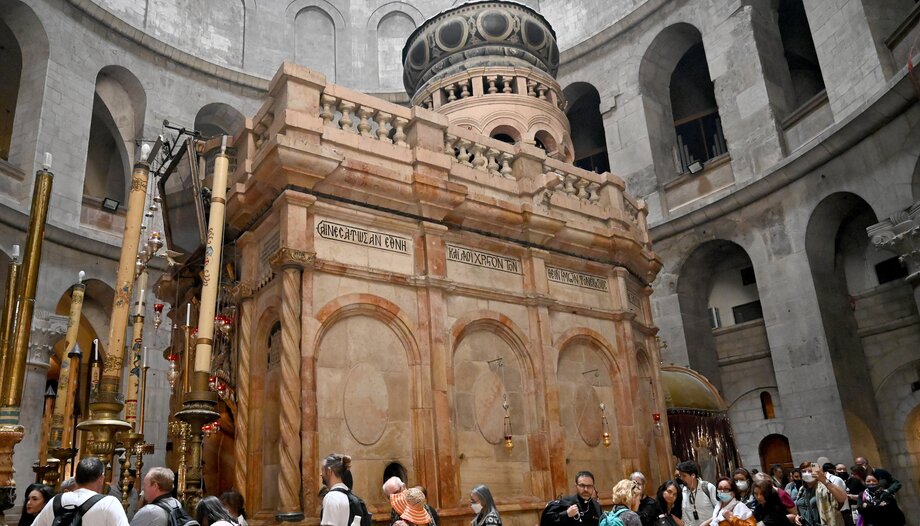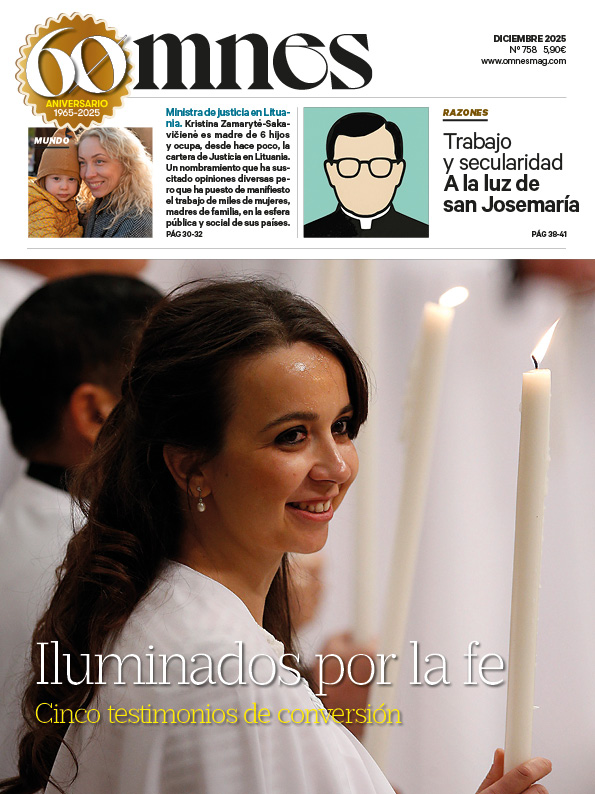Since the first centuries of Christianity and before that, with the preservation of the memory of the Jewish people, the holy places have been the object of custody and veneration.
The oral traditions handed down from generation to generation have often been scientifically supported by archaeological research and excavations carried out, especially in the last two centuries.
Pilgrimage to the Holy Land is more than a journey; it is a journey, in a way, to the Gospel, so it is especially useful to make them with guides that combine both aspects as "Traces of our Faith", published by the Foundation. Saxum.
Among the many holy places that are guarded among Israel and PalestineSome of them stand out for their devotional, archaeological and historical interest.
Mary's house in Nazareth
The Basilica of the Annunciation in Nazareth stands on the remains of Christian places of worship dating back to the first centuries of Christianity.
In the archaeological research that the "Studium Biblicum Franciscanum" carried out before erecting the present basilica, they found a building dedicated to worship, in which there were numerous Christian graffiti, dating from the late 1st and 2nd centuries. Among them, an inscription "Ave Maria" in Greek stands out. Tastings carried out on the walls of this house, partially excavated in rock, as was customary at the time, relate them to those kept in the basilica of Loreto, in Italy.
The Bethlehem Grotto
The location of the cattle cave where Christ was born was already known in the middle of the second century. Bethlehem was announced by Micah as the birthplace of the Messiah and the birth of Christ is recorded in the Gospel of Luke (Lk 2:1-7).
To the location of the cave transmitted by the first Christians is added the fact that, as happened with other holy places related to Judaism and Christianity, the Roman authority wanted to "erase" them by building on them pagan temples or sacred groves, as was the case of the grotto of Bethlehem. These attempts at silencing not only did not succeed, but also marked, in a way, the most important places.
The grotto in question is today inside a 4th century basilica, exactly on a lower floor, under the presbytery. It is an excavation in the rock, usual in the Judea of the 1st century to keep shepherding equipment or the animals themselves. The cleft in the rock that is preserved on one side is, according to tradition, the first place where the Son of God rested on earth. Today, a silver star marks this place.
Temple of Jerusalem
The place where the Temple of Jerusalem stood has been one of the most studied of all those in the Holy Land. It is the holiest place for the Jews and has special importance for the followers of the Muslim religion as well.
The first great temple in Jerusalem was ordered to be built by David and it was his son, Solomon, who completed and consecrated it in the eleventh year of his reign, that is, around 960 B.C. (Kings 5, 15 - 7).
Although there are numerous sources that speak of this temple, archaeological research has not been able to find significant remains of this huge and rich construction.
After the return of the Jewish people to Jerusalem, the building of the second, more modest temple began, which was dedicated in 515.
Beginning in 20 B.C., Herod the Great began the restoration and enlargement of the Temple of Jerusalem. This great temple is where St. Joseph and the Virgin Mary went to present an almost newborn Jesus.
The evangelists Matthew, Mark and Luke record Christ's prophecy about the destruction of the Temple. A reality that was seen by many of those who heard it since, in the year 70, the temple was burned by the Roman legions during the siege of Jerusalem. Half a century later, on these ruins, monuments with statues of Jupiter and the emperor were erected. Various studies and excavations, which are still continuing, have been able to virtually reconstruct this great temple.
In Jerusalem, part of the walls of that construction still remain, although the best known is the western wall that we know as the Wailing Wall: approximately 60 meters long and about 20 meters high. Since the 14th century it has been the holy place of prayer for the Jews. This wall is the closest to the place where the Holy of Holies was located, which experts place linearly under the ground now occupied by the Dome of the Rock of the Al Aqsa Mosque.
Capernaum: the synagogue and the house of Peter
The synagogue of Capernaum, together with the synagogue recently found in Magdala, is one of the best preserved and most artistically valuable synagogues known.
The remains found show a rich building, quite large, built with white limestone and profusely decorated in its columns and arches. Although these remains date from approximately between the 4th and 5th centuries, this synagogue was built over an earlier, 1st century synagogue of which stone pavement has been found under the central nave of the prayer hall and in which Jesus may well have prayed and taught (Mk 1:21-28; Lk 4:31-37).
A few meters from this synagogue there is a basilica from the end of the 5th century, built on an octagonal structure that, according to an ancient tradition, stands on the site where the house of St. Peter once stood, where Jesus cured his mother-in-law (Mt 8:14-15; Mk 1:29-31; Lk 4:38-39). Various excavations have confirmed that, in fact, the basilica stands on what was once a 1st century B.C. dwelling consisting of a series of rooms connected by a courtyard.
Pool of Bethesda or Betzata
Although it is not a center of devotion, the accuracy with which this set of pools found in successive excavations in the nineteenth, twentieth and twenty-first centuries is described makes this enclave one of the most interesting places as a confirmation, in stone, of the Scriptures.
Located in the exact spot where the Scriptures locate it, its ruins are currently located in the Muslim quarter of Jerusalem, a few meters from the Lions' Gate (known as the Sheep Gate, through which the cattle entered for the sacrifice in the Temple). The excavations show a pool divided by a wall that created two separate basins, which speak of the great construction that this pool entailed, of which the evangelist St. John notes that it had "five porticoes" (Jn 5:1-3).
The place of the crucifixion and burial of Jesus
The large model that can be seen in the Israel Museum, corresponding to the physiognomy of Jerusalem in the time of the Second Temple, shows the limits of the walls of the city.
city at that time. These limits leave out, as the Gospels narrate, the rock with a shape approximating that of a skull that protruded from a quarry in the northeastern part of the city (Mt 27:32-56; Mk 15:21-41; Lk 23:26-49; Jn 19:17-30). That was the point where the crucifixion and death of Christ took place and, a few meters away, on a rock, the burial of the body of the Lord.
This area of the holy city has been the main subject of archaeological research and excavations that have been revealing various rooms, areas and burials that follow the line narrated in the Holy Scriptures.
The Roman conquest buried this area under a pagan temple, which meant that it was exceptionally well preserved. In the 4th century when, with the Christianization of the Empire, these holy places became a place of Christian veneration again.
The first basilica built on the Holy Sepulchre dates from this date, and excavations have revealed three zones: a circular mausoleum around the tomb; a courtyard, where the rock of Calvary was in the open air, and a basilica with five naves and an atrium. The tomb was isolated from the rock, cutting it and building the edicule that protects it. In 2016, with the latest restoration of the current edicule (from 1810), the overlapping marble slabs were removed down to the original stone. Today, the entire plot, from the tomb of Jesus to the place of the crucifixion, is part of the temple complex.
In addition to being able to touch the hollow of the Cross in what is today the Calvary Chapel, just below, in the Adam Chapel, part of the original rock can be seen.
"Touching" the Gospel
To set foot in the Holy Land is, in a way, to enter personally into the life of the Gospel. As Jesús Gil, priest and author of "Footsteps of Our Faith" points out, "the Gospels are read with different eyes after having passed through the Holy Land. I remember reading to a group in Capernaum the beginning of the Gospel according to St. Mark, from verse 14 of the first chapter to verse 12 of the second. Listened to there, under the shade of the sycamore trees, among the ruins of the synagogue and Peter's house, it suddenly made sense, it became alive. One person said to me: 'That piece of the Gospel is true. And if that piece is true, then the whole Gospel is true.








